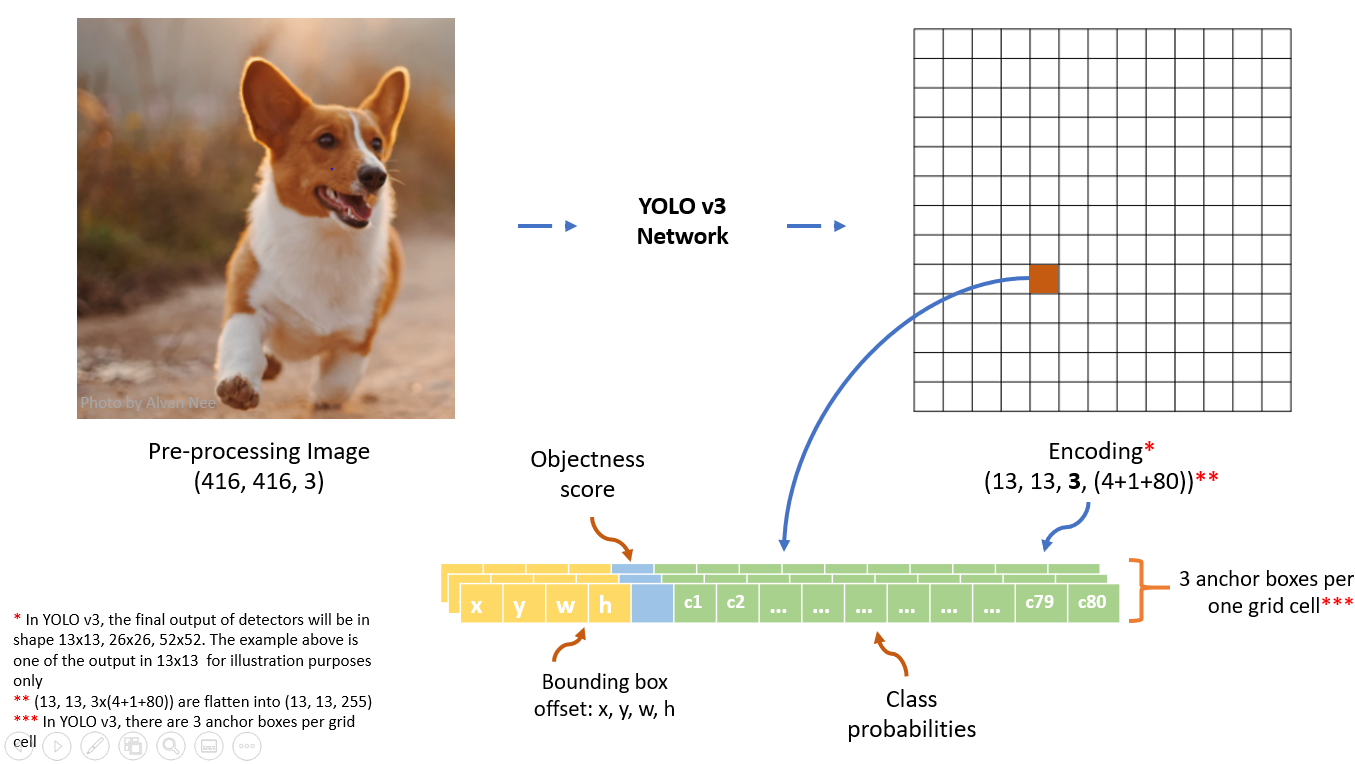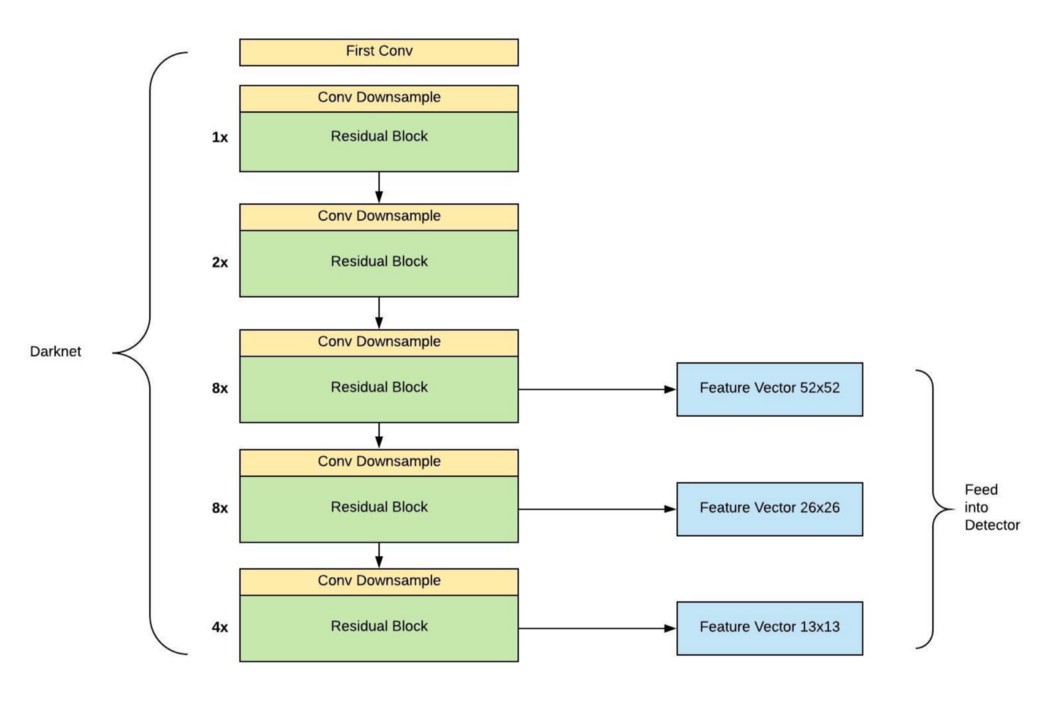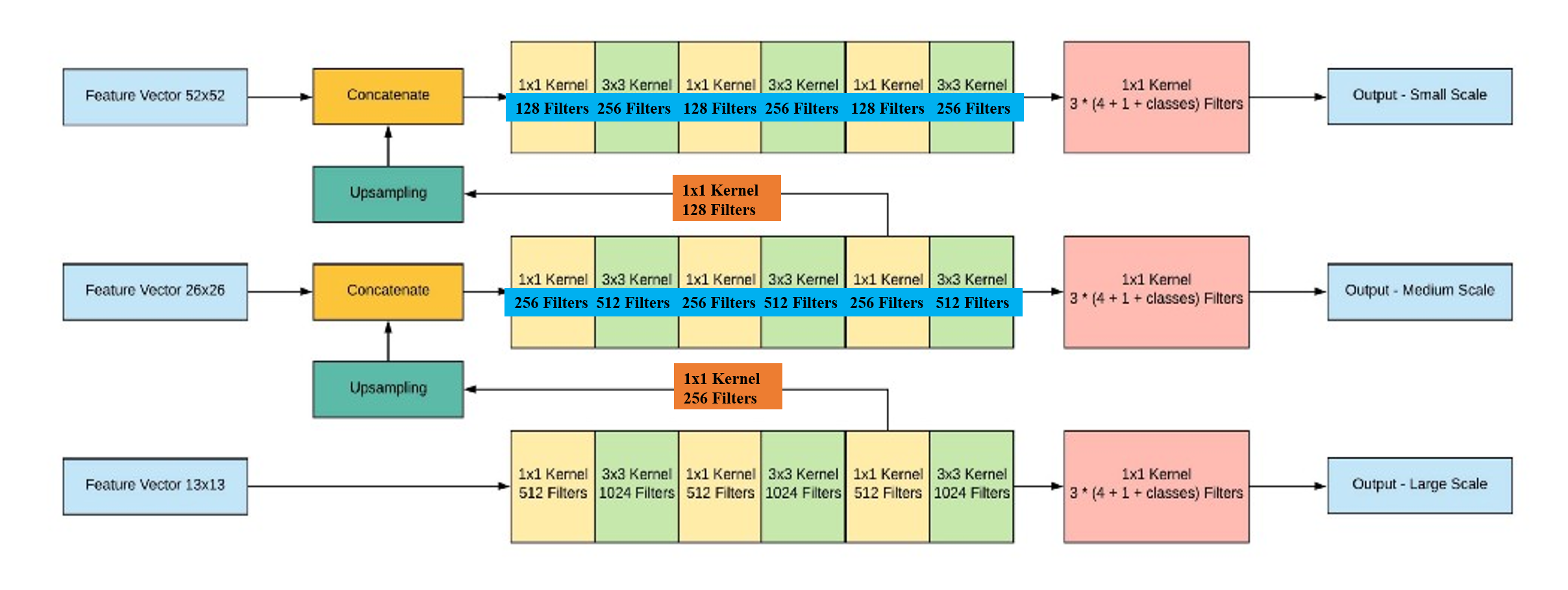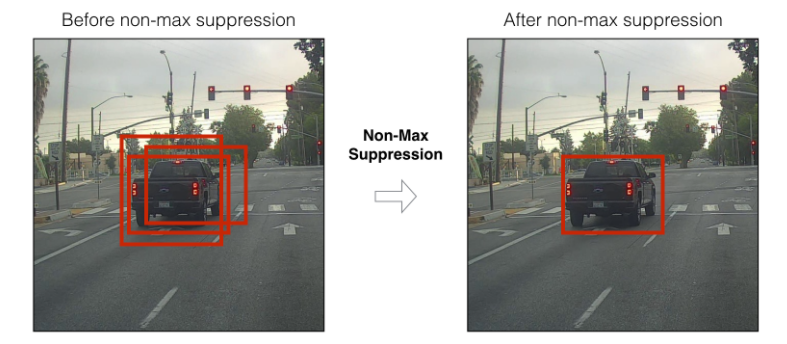YOLO v3算法介绍

图片来自https://towardsdatascience.com/yolo-v3-object-detection-with-keras-461d2cfccef6
数据前处理
输入的图片维数:(416, 416, 3)
输入的图片标注:$[(x_1, y_1, x_2, y_2, class{\_}index), (x_1, y_1, x_2, y_2,class{\_}index), \ldots, (x_1, y_1, x_2, y_2,class{\_}index)]$ 表示图片中标注的所有真实box,其中$class{\_}index$代表对应的box所属的类别,$(x_1, y_1)$表示对应的box左上角的坐标值,$(x_2, y_2)$表示对应的box右下角的坐标值
YOLO v3共有9个anchor box,每个detector中有3个anchor box。YOLO v3中anchor box的确定方法是对训练集中的所有真实box进行聚类得到的,聚类距离通过IoU来定义,IoU越大,距离越小:$$d(\text {box}, \text {centroid})=1-\operatorname{IoU}(\text {box}, \text {centroid})$$IoU的定义如下图所示:

前处理中最重要的一步就是将图片标注转化为模型的输出格式。首先要确定每个box对应哪个anchor box (与box的IoU最大的那个anchor box),然后将box的信息写在对应的anchor box的位置。


###########以下代码仅用作说明,并未考虑性能和代码结构##########
train_output_sizes = [52, 26, 13]
label = [np.zeros((train_output_sizes[i], train_output_sizes[i], 3, 85)) for i in range(3)]
bboxes_count = np.zeros((3,))
max_bbox_per_scale = 150 #每个detector中具有的真实box的最大数量
bboxes_xywh = [np.zeros((max_bbox_per_scale, 4)) for _ in range(3)]
# YOLO v3默认的9个anchor box的width和height
anchors = [[(10,13), (16,30), (33,23)], [(30,61), (62,45), (59,119)], [(116,90), (156,198), (373,326)]]
# bboxes为一张图片中标注的所有真实box
for bbox in bboxes:
bbox_coor = bbox[:4]
bbox_class_ind = bbox[4]
#onehot encode for class
onehot = np.zeros(80, dtype=np.float)
onehot[bbox_class_ind] = 1.0
# 将box的坐标(x1,y1,x2,y2)转换成(xc, yc, width, height)
bbox_xywh = np.concatenate([(bbox_coor[2:] + bbox_coor[:2]) * 0.5, bbox_coor[2:] - bbox_coor[:2]], axis=-1)
# 找到和box有最大IoU的anchor box
iou = []
for anchors_detector in anchors:
for anchor in anchors_detector:
intersection = min(bbox_xywh[2], anchor[0])*min(bbox_xywh[3], anchor[1])
box_area = bbox_xywh[2]*bbox_xywh[3]
anchor_area = anchor[0] * anchor[1]
iou.append(intersection / (box_area + anchor_area - intersection))
anchor_idx = np.argmax(np.array(iou))
# 将anchor_idx转换到对应的输出位置
best_detect = int(anchor_idx/3)
best_anchor = int(anchor_idx % 3)
scale = int(416/train_output_sizes[best_detect])
xind, yind = int(bbox_xywh[0]/scale), int(bbox_xywh[1]/scale)
label[best_detect][yind, xind, best_anchor, 0:4] = bbox_xywh
label[best_detect][yind, xind, best_anchor, 4:5] = 1.0
label[best_detect][yind, xind, best_anchor, 5:] = onehot
# 存储box的信息
bboxes_xywh[best_detect][bboxes_count[best_detect], :4] = bbox_xywh
bboxes_count[best_detect] += 1
label_sbbox, label_mbbox, label_lbbox = label
sbboxes, mbboxes, lbboxes = bboxes_xywh
模型架构
YOLO v3的架构搭建主要分为两个部分,第一部分基于Darknet网络构建52x52, 26x26, 13x13的特征图,第二部分构建基于这三类特征图的探测器,如下图所示:


图片来自https://towardsdatascience.com/dive-really-deep-into-yolo-v3-a-beginners-guide-9e3d2666280e (对其中的错误进行了修正)


### convolutional and residual blocks
def _conv_block(inp, convs, skip=True):
x = inp
count = 0
for conv in convs:
# skip over 2 layers
if count == (len(convs) - 2) and skip:
skip_connection = x
count += 1
if conv['stride'] > 1: x = ZeroPadding2D(((1,0),(1,0)))(x) # left and top padding
x = Conv2D(conv['filter'],
conv['kernel'],
strides=conv['stride'],
padding='valid' if conv['stride'] > 1 else 'same',
name='conv_' + str(conv['layer_idx']),
use_bias=False if conv['bnorm'] else True)(x)
if conv['bnorm']: x = BatchNormalization(epsilon=0.001, name='bnorm_' + str(conv['layer_idx']))(x)
if conv['leaky']: x = LeakyReLU(alpha=0.1, name='leaky_' + str(conv['layer_idx']))(x)
return Add()([skip_connection, x]) if skip else x ### backbone
def make_yolov3_model():
input_image = Input(shape=(None, None, 3)) #(416, 416,3)
###### Part 1 ######
# (208, 208, 64)
x = _conv_block(input_image, [{'filter': 32, 'kernel': 3, 'stride': 1, 'bnorm': True, 'leaky': True, 'layer_idx': 0},
{'filter': 64, 'kernel': 3, 'stride': 2, 'bnorm': True, 'leaky': True, 'layer_idx': 1},
{'filter': 32, 'kernel': 1, 'stride': 1, 'bnorm': True, 'leaky': True, 'layer_idx': 2},
{'filter': 64, 'kernel': 3, 'stride': 1, 'bnorm': True, 'leaky': True, 'layer_idx': 3}])
# (104, 104, 128)
x = _conv_block(x, [{'filter': 128, 'kernel': 3, 'stride': 2, 'bnorm': True, 'leaky': True, 'layer_idx': 5},
{'filter': 64, 'kernel': 1, 'stride': 1, 'bnorm': True, 'leaky': True, 'layer_idx': 6},
{'filter': 128, 'kernel': 3, 'stride': 1, 'bnorm': True, 'leaky': True, 'layer_idx': 7}])
# (104, 104, 128)
x = _conv_block(x, [{'filter': 64, 'kernel': 1, 'stride': 1, 'bnorm': True, 'leaky': True, 'layer_idx': 9},
{'filter': 128, 'kernel': 3, 'stride': 1, 'bnorm': True, 'leaky': True, 'layer_idx': 10}])
# (52, 52, 256)
x = _conv_block(x, [{'filter': 256, 'kernel': 3, 'stride': 2, 'bnorm': True, 'leaky': True, 'layer_idx': 12},
{'filter': 128, 'kernel': 1, 'stride': 1, 'bnorm': True, 'leaky': True, 'layer_idx': 13},
{'filter': 256, 'kernel': 3, 'stride': 1, 'bnorm': True, 'leaky': True, 'layer_idx': 14}])
# (52, 52, 256)
for i in range(7):
x = _conv_block(x, [{'filter': 128, 'kernel': 1, 'stride': 1, 'bnorm': True, 'leaky': True, 'layer_idx': 16+i*3},
{'filter': 256, 'kernel': 3, 'stride': 1, 'bnorm': True, 'leaky': True, 'layer_idx': 17+i*3}])
skip_36 = x #52x52 feature map
# (26, 26, 512)
x = _conv_block(x, [{'filter': 512, 'kernel': 3, 'stride': 2, 'bnorm': True, 'leaky': True, 'layer_idx': 37},
{'filter': 256, 'kernel': 1, 'stride': 1, 'bnorm': True, 'leaky': True, 'layer_idx': 38},
{'filter': 512, 'kernel': 3, 'stride': 1, 'bnorm': True, 'leaky': True, 'layer_idx': 39}])
# (26, 26, 512)
for i in range(7):
x = _conv_block(x, [{'filter': 256, 'kernel': 1, 'stride': 1, 'bnorm': True, 'leaky': True, 'layer_idx': 41+i*3},
{'filter': 512, 'kernel': 3, 'stride': 1, 'bnorm': True, 'leaky': True, 'layer_idx': 42+i*3}])
skip_61 = x #26x26 feature map
# (13, 13, 1024)
x = _conv_block(x, [{'filter': 1024, 'kernel': 3, 'stride': 2, 'bnorm': True, 'leaky': True, 'layer_idx': 62},
{'filter': 512, 'kernel': 1, 'stride': 1, 'bnorm': True, 'leaky': True, 'layer_idx': 63},
{'filter': 1024, 'kernel': 3, 'stride': 1, 'bnorm': True, 'leaky': True, 'layer_idx': 64}])
# (13, 13, 1024)
for i in range(3):
x = _conv_block(x, [{'filter': 512, 'kernel': 1, 'stride': 1, 'bnorm': True, 'leaky': True, 'layer_idx': 66+i*3},
{'filter': 1024, 'kernel': 3, 'stride': 1, 'bnorm': True, 'leaky': True, 'layer_idx': 67+i*3}]) #13x13 feature map
###### Part 2 ######
# (13, 13, 512)
x = _conv_block(x, [{'filter': 512, 'kernel': 1, 'stride': 1, 'bnorm': True, 'leaky': True, 'layer_idx': 75},
{'filter': 1024, 'kernel': 3, 'stride': 1, 'bnorm': True, 'leaky': True, 'layer_idx': 76},
{'filter': 512, 'kernel': 1, 'stride': 1, 'bnorm': True, 'leaky': True, 'layer_idx': 77},
{'filter': 1024, 'kernel': 3, 'stride': 1, 'bnorm': True, 'leaky': True, 'layer_idx': 78},
{'filter': 512, 'kernel': 1, 'stride': 1, 'bnorm': True, 'leaky': True, 'layer_idx': 79}], skip=False)
# (13, 13, 255)
yolo_82 = _conv_block(x, [{'filter': 1024, 'kernel': 3, 'stride': 1, 'bnorm': True, 'leaky': True, 'layer_idx': 80},
{'filter': 255, 'kernel': 1, 'stride': 1, 'bnorm': False, 'leaky': False, 'layer_idx': 81}], skip=False) #13x13 detector
# concatenate with 26x26 feature map, (26, 26, 256+512)
x = _conv_block(x, [{'filter': 256, 'kernel': 1, 'stride': 1, 'bnorm': True, 'leaky': True, 'layer_idx': 84}], skip=False)
x = UpSampling2D(2)(x)
x = Concatenate()([x, skip_61])
# (26, 26, 256)
x = _conv_block(x, [{'filter': 256, 'kernel': 1, 'stride': 1, 'bnorm': True, 'leaky': True, 'layer_idx': 87},
{'filter': 512, 'kernel': 3, 'stride': 1, 'bnorm': True, 'leaky': True, 'layer_idx': 88},
{'filter': 256, 'kernel': 1, 'stride': 1, 'bnorm': True, 'leaky': True, 'layer_idx': 89},
{'filter': 512, 'kernel': 3, 'stride': 1, 'bnorm': True, 'leaky': True, 'layer_idx': 90},
{'filter': 256, 'kernel': 1, 'stride': 1, 'bnorm': True, 'leaky': True, 'layer_idx': 91}], skip=False)
# (26, 26, 255)
yolo_94 = _conv_block(x, [{'filter': 512, 'kernel': 3, 'stride': 1, 'bnorm': True, 'leaky': True, 'layer_idx': 92},
{'filter': 255, 'kernel': 1, 'stride': 1, 'bnorm': False, 'leaky': False, 'layer_idx': 93}], skip=False) #26x26 detector
# concatenate with 52x52 feature map, (52, 52, 128+256)
x = _conv_block(x, [{'filter': 128, 'kernel': 1, 'stride': 1, 'bnorm': True, 'leaky': True, 'layer_idx': 96}], skip=False)
x = UpSampling2D(2)(x)
x = Concatenate()([x, skip_36])
# (52, 52, 255)
yolo_106 = _conv_block(x, [{'filter': 128, 'kernel': 1, 'stride': 1, 'bnorm': True, 'leaky': True, 'layer_idx': 99},
{'filter': 256, 'kernel': 3, 'stride': 1, 'bnorm': True, 'leaky': True, 'layer_idx': 100},
{'filter': 128, 'kernel': 1, 'stride': 1, 'bnorm': True, 'leaky': True, 'layer_idx': 101},
{'filter': 256, 'kernel': 3, 'stride': 1, 'bnorm': True, 'leaky': True, 'layer_idx': 102},
{'filter': 128, 'kernel': 1, 'stride': 1, 'bnorm': True, 'leaky': True, 'layer_idx': 103},
{'filter': 256, 'kernel': 3, 'stride': 1, 'bnorm': True, 'leaky': True, 'layer_idx': 104},
{'filter': 255, 'kernel': 1, 'stride': 1, 'bnorm': False, 'leaky': False, 'layer_idx': 105}], skip=False) #52x52 detector
model = Model(input_image, [yolo_82, yolo_94, yolo_106])
return model
损失函数
YOLO v3中的损失函数有许多不同的变种,这里选取一种比较经典的进行介绍。损失函数可以分解为边框损失、目标损失以及分类损失这三项之和,下面对这三项逐一进行介绍。
边框损失:原始论文中使用MSE(均方误差)作为边框的损失函数,但是不同质量的预测结果,利用MSE有时候并不能区分开来。使用IoU更能体现回归框的质量,并且具有尺度不变性,但是IoU仅能描述两个边框重叠的面积,不能描述两个边框重叠的形式;并且若两个边框完全不相交,则IoU为0,不适合继续进行梯度优化。GIoU (Generalized IoU)继承了IoU的优点,并且一定程度上解决了IoU存在的问题:$$G I o U=I o U-\frac{|C \backslash(B_1 \cup B_2)|}{|C|}$$其中$C$为包含$B_1$与$B_2$的最小封闭形状。边框损失可表示为$1-G I o U$,下面以13x13这一检测器为例来计算边框损失,总的边框损失为三个检测器的损失之和。
要计算边框损失,首先要对YOLO v3的网络输出进行转换,假设网络输出的边框信息为$(t_x,t_y,t_w,t_h)$,其中$(t_x,t_y)$为边框中心点信息,$(t_w,t_h)$为边框的宽度和高度信息,转换公式如下所示:$$b_x=sigmoid(t_x)+c_x;\text{ }b_y=sigmoid(t_y)+c_y;\text{ }b_w=p_wexp(t_w);\text{ }b_h=p_hexp(t_h)$$其中$(c_x,c_y)$表示$(t_x,t_y)$所在网格的左上角那个点的坐标位置,$(p_w,p_h)$表示边框对应的anchor box的宽度和高度。


output_size = 13
anchors = np.array([[116,90], [156,198], [373,326]]) #anchor boxes in 13x13 detector, 参见数据前处理代码部分
# yolo_82_batch: 13x13 detector output, (batch_size, 13, 13, 255), yolo_82的计算参见模型架构代码部分
conv_output = tf.reshape(yolo_82_batch, (batch_size, output_size, output_size, 3, 85)) #(batch_size, 13, 13, 3, 85)
t_xy, t_wh, objectness, classes = tf.split(conv_output, (2, 2, 1, 80), axis=-1) #t_xy:(batch_size, 13, 13, 3, 2); t_wh:(batch_size, 13, 13, 3, 2)
c_xy = tf.meshgrid(tf.range(output_size), tf.range(output_size)) #a list of two (13,13) arrays
c_xy = tf.stack(c_xy, axis=-1) #(13,13,2)
c_xy = tf.tile(c_xy[tf.newaxis, :, :, tf.newaxis, :], [batch_size, 1, 1, 3, 1]) #(batch_size,13,13,3,2)
scale = int(416/output_size)
b_xy = (tf.sigmoid(t_xy) + c_xy) * scale #(batch_size,13,13,3,2)
b_wh = tf.exp(t_wh) * anchors #(batch_size,13,13,3,2)
b_xywh = tf.concat([b_xy, b_wh], axis=-1) #(batch_size,13,13,3,4)
接下来计算网络输出的边框与真实边框的GIoU,进而得到边框损失:


def bbox_giou(boxes1, boxes2):
# transform from (xc, yc, w, h) to (xmin, ymin, xmax, ymax)
boxes1 = tf.concat([boxes1[..., :2] - boxes1[..., 2:] * 0.5,
boxes1[..., :2] + boxes1[..., 2:] * 0.5], axis=-1)
boxes2 = tf.concat([boxes2[..., :2] - boxes2[..., 2:] * 0.5,
boxes2[..., :2] + boxes2[..., 2:] * 0.5], axis=-1)
# two box aeras
boxes1_area = (boxes1[..., 2] - boxes1[..., 0]) * (boxes1[..., 3] - boxes1[..., 1])
boxes2_area = (boxes2[..., 2] - boxes2[..., 0]) * (boxes2[..., 3] - boxes2[..., 1])
# intersection area
left_up = tf.maximum(boxes1[..., :2], boxes2[..., :2])
right_down = tf.minimum(boxes1[..., 2:], boxes2[..., 2:])
inter_section = tf.maximum(right_down - left_up, 0.0)
inter_area = inter_section[..., 0] * inter_section[..., 1]
# compute iou
union_area = boxes1_area + boxes2_area - inter_area
iou = inter_area / union_area
# enclosed area
enclose_left_up = tf.minimum(boxes1[..., :2], boxes2[..., :2])
enclose_right_down = tf.maximum(boxes1[..., 2:], boxes2[..., 2:])
enclose = tf.maximum(enclose_right_down - enclose_left_up, 0.0)
enclose_area = enclose[..., 0] * enclose[..., 1]
# compute giou
giou = iou - 1.0 * (enclose_area - union_area) / enclose_area
return giou ### label_lbbox_batch: ground truth boxes in 13x13 detector, (batch_size, 13, 13, 3, 85), label_lbbox的计算参见数据前处理代码部分
label_xywh = label_lbbox_batch[:, :, :, :, 0:4] #ground truth box (xc, yc, w, h)
respond_bbox = label_lbbox_batch[:, :, :, :, 4:5] #对应的anchor box内是否有真实对象存在,为1则计算边框损失,为0则忽略
giou = tf.expand_dims(bbox_giou(b_xywh, label_xywh), axis=-1) #(batch_size, 13, 13, 3, 1)
input_size = tf.cast(416, tf.float32)
bbox_loss_scale = 2.0 - 1.0 * label_xywh[:, :, :, :, 2:3] * label_xywh[:, :, :, :, 3:4] / (input_size ** 2) #边框损失的权重,对应的ground truth box的面积越大,对错误的容忍率越高,赋予的权重越小
giou_loss = respond_bbox * bbox_loss_scale * (1- giou) #giou loss, (batch_size, 13, 13, 3, 1)
目标损失:仍以13x13这一检测器为例来计算,目标损失实际上是一个不平衡二分类问题,因为一般来说检测器的13x13x3个anchor box内真实对象(正样本)的数量要远小于没有真实对象(负样本)的数量。采用Focal Loss来处理这一问题,Focal Loss对难分类的样本采用较大的权重,对易分类的样本采用较小的权重:$$F L(p)=\left\{\begin{aligned}-(1-p)^{\gamma} \log (p), & \text { positive samples } \\ -p^{\gamma} \log (1-p), & \text { negative samples }\end{aligned}\right.$$Focal Loss还有另外一种公式,即在上述基础上引入类别权重$\alpha$:$$F L(p)=\left\{\begin{aligned}-\alpha(1-p)^{\gamma} \log (p), & \text { positive samples} \\ -(1-\alpha) p^{\gamma} \log (1-p), & \text { negative samples }\end{aligned}\right.$$本文采用第一种公式,并将$\gamma$设为2。另外在目标损失的计算过程中对负样本的定义进行了一定修改,如果一个anchor box内没有真实对象,但它预测的边框和对应的探测器上的某个真实边框有较大的IoU,那么就不把它作为负样本,从而在损失计算过程中忽略它,这也在一定程度上减少了负样本的数量。


### lbboxes_batch: 13x13探测器上存在的所有ground truth box的(xc,yc,w,h)信息, (batch_size, max_bbox_per_scale, 4), lbboxes的计算参见数据前处理代码部分
### label_lbbox_batch: ground truth boxes in 13x13 detector, (batch_size, 13, 13, 3, 85), label_lbbox的计算参见数据前处理代码部分
### objectness:预测的对象真实度, (batch_size, 13, 13, 3, 1), 参见边框损失中的输出转换代码部分
### b_xywh: 预测的边框信息,(batch_size, 13, 13, 3, 4), 参见边框损失中的输出转换代码部分
respond_bbox = label_lbbox_batch[:, :, :, :, 4:5] #对应的anchor box内是否有真实对象存在,为1则为正样本,为0则为负样本
### 减少进行计算的负样本的数量 ###
### 1. 计算预测的box与所有真实box的IoU ###
boxes1 = tf.tile(lbboxes_batch[:, tf.newaxis, tf.newaxis, tf.newaxis, :, :], [1, 13, 13, 3, 1, 1]) #(batch_size, 13, 13, 3, max_bbox_per_scale, 4)
boxes2 = tf.tile(b_xywh[:, :, :, :, tf.newaxis, :], [1, 1, 1, 1, max_bbox_per_scale, 1]) #(batch_size, 13, 13, 3, max_bbox_per_scale, 4)
boxes1_area = boxes1[..., 2] * boxes1[..., 3]
boxes2_area = boxes2[..., 2] * boxes2[..., 3]
# (xc, yc, w, h)->(xmin, ymin, xmax, ymax)
boxes1 = tf.concat([boxes1[..., :2] - boxes1[..., 2:] * 0.5, boxes1[..., :2] + boxes1[..., 2:] * 0.5], axis=-1)
boxes2 = tf.concat([boxes2[..., :2] - boxes2[..., 2:] * 0.5, boxes2[..., :2] + boxes2[..., 2:] * 0.5], axis=-1)
# compute IoU
left_up = tf.maximum(boxes1[..., :2], boxes2[..., :2])
right_down = tf.minimum(boxes1[..., 2:], boxes2[..., 2:])
inter_section = tf.maximum(right_down - left_up, 0.0)
inter_area = inter_section[..., 0] * inter_section[..., 1]
union_area = boxes1_area + boxes2_area - inter_area
iou = 1.0 * inter_area / union_area #(batch_size, 13, 13, 3, max_bbox_per_scale)
### 2. 寻找最大的IoU,若该值大于给定的临界值,则在损失计算中忽略该样本###
max_iou = tf.expand_dims(tf.reduce_max(iou, axis=-1), axis=-1) #(batch_size, 13, 13, 3, 1)
IOU_LOSS_THRESH = 0.5
respond_bgd = (1.0 - respond_bbox) * tf.cast( max_iou < IOU_LOSS_THRESH, tf.float32) #(batch_size, 13, 13, 3, 1)
###########################
pred_conf = tf.sigmoid(objectness) #预测为真实对象的概率
conf_focal = tf.pow(respond_bbox - pred_conf, 2) #gamma=2
focal_loss_p = conf_focal * respond_bbox * tf.nn.sigmoid_cross_entropy_with_logits(labels=respond_bbox, logits=objectness) #正样本损失
focal_loss_n = conf_focal * respond_bgd * tf.nn.sigmoid_cross_entropy_with_logits(labels=respond_bbox, logits=objectness) #负样本损失
focal_loss = focal_loss_p + focal_loss_n #(batch_size, 13, 13, 3, 1)
分类损失:仍以13x13这一检测器为例来计算,使用交叉熵损失函数,值得注意的是在YOLO v3的类别预测中使用sigmoid作为激活函数代替之前的softmax,主要是因为不同的类别不一定是互斥的,一个对象可能会同时属于多个类别。


### label_lbbox_batch: ground truth boxes in 13x13 detector, (batch_size, 13, 13, 3, 85), label_lbbox的计算参见数据前处理代码部分
### classes: 预测对象所属的类别,(batch_size, 13, 13, 3, 80), 参见边框损失中的输出转换代码部分
respond_bbox = label_lbbox_batch[:, :, :, :, 4:5] #对应的anchor box内是否有真实对象存在,为1则计算分类损失,为0则忽略
labels_onehot = label_lbbox_batch[:, :, :, :, 5:] #对象所属的真实类别
classes_prob = tf.sigmoid(classes) #预测属于每个类别的概率
ce_loss = respond_bbox * tf.nn.sigmoid_cross_entropy_with_logits(labels=labels_onehot, logits=classes) #cross entropy loss, (batch_size, 13, 13, 3, 80)
综合上述的三类损失,可以计算出在13x13探测器上的总损失,其余两个探测器 (26x26, 52x52) 上的损失可采取同样的方法计算,三个探测器的总损失为:


giou_loss_13 = tf.reduce_mean(tf.reduce_sum(giou_loss, axis=[1,2,3,4]))
focal_loss_13 = tf.reduce_mean(tf.reduce_sum(focal_loss, axis=[1,2,3,4]))
ce_loss_13 = tf.reduce_mean(tf.reduce_sum(ce_loss, axis=[1,2,3,4]))
total_loss_13 = giou_loss_13 + focal_loss_13 + ce_loss_13
# total loss
total_loss = total_loss_13 + total_loss_26 + total_loss_52
模型预测
同损失函数这一部分中的介绍,首先将网络输出的格式进行转换:


### 仍以13x13检测器为例, 输入的待预测图片的维数为(1, 416, 416, 3)
### b_xywh, pred_conf, classes_prob的计算参见损失函数代码部分
output_13 = tf.concat([b_xywh, pred_conf, classes_prob], axis=-1) #(batch_size, 13, 13, 3, 85),此时的batch_size为1
### 同样的方式可以计算出output_26 (26x26检测器), output_52 (52x52检测器)
### output_26: (1, 26, 26, 3, 85); output_52: (1, 52, 52, 3, 85)
pred_bbox = [tf.reshape(x, (-1, tf.shape(x)[-1])) for x in (output_13, output_26, output_52)] #[(13*13*3, 85), (26*26*3, 85), (52*52*3, 85)]
pred_bbox = tf.concat(pred_bbox, axis=0) #预测得到的所有box的信息, (13*13*3+26*26*3+52*52*3, 85)
接下来删除得分较低的预测box,得分通过box内为真实对象的概率乘以最大的类别概率进行确定


score_threshold = 0.5
pred_xywh = pred_bbox[:, 0:4]
# (xc, yc, w, h) --> (xmin, ymin, xmax, ymax) for computing IoU
pred_coor = np.concatenate([pred_xywh[:, :2] - pred_xywh[:, 2:] * 0.5, pred_xywh[:, :2] + pred_xywh[:, 2:] * 0.5], axis=-1)
# compute box score
pred_conf = pred_bbox[:, 4]
pred_prob = pred_bbox[:, 5:]
classes = np.argmax(pred_prob, axis=-1) #每个box预测的对应最大概率的类别
scores = pred_conf * np.max(pred_prob, axis=-1)
# discard boxes with low scores
mask = scores > score_threshold
coors, scores, classes = pred_coor[mask], scores[mask], classes[mask]
filter_boxes = np.concatenate([coors, scores[:, np.newaxis], classes[:, np.newaxis]], axis=-1) #(number of remaining boxes, 6)
对剩余的预测box进行Non-Maximum Suppression (NMS),NMS的主要目的是去除预测类别相同但是重叠度比较大的box:



iou_threshold = 0.5
classes_in_img = list(set(filter_boxes[:, 5])) #图片上的所有预测类别
best_bboxes = [] #最终剩余的box
for cls in classes_in_img:
cls_mask = (filter_boxes[:, 5] == cls)
cls_bboxes = filter_boxes[cls_mask] #预测为同一类别的所有box
while len(cls_bboxes) > 0:
max_ind = np.argmax(cls_bboxes[:, 4])
best_bbox = cls_bboxes[max_ind] #剩余box中得分最高的box
best_bboxes.append(best_bbox)
### 计算得分最高的box与剩余box的IoU ###
cls_bboxes = np.concatenate([cls_bboxes[: max_ind], cls_bboxes[max_ind + 1:]], axis=0) #剩余box (不包括得分最高的box)
best_bbox_xy = best_bbox[np.newaxis, :4]
cls_bboxes_xy = cls_bboxes[:, :4]
### IoU
best_bbox_area = (best_bbox_xy[:, 2] - best_bbox_xy[:, 0]) * (best_bbox_xy[:, 3] - best_bbox_xy[:, 1])
cls_bboxes_area = (cls_bboxes_xy[:, 2] - cls_bboxes_xy[:, 0]) * (cls_bboxes_xy[:, 3] - cls_bboxes_xy[:, 1])
left_up = np.maximum(best_bbox_xy[:, :2], cls_bboxes_xy[:, :2])
right_down = np.minimum(best_bbox_xy[:, 2:], cls_bboxes_xy[:, 2:])
inter_section = np.maximum(right_down - left_up, 0.0)
inter_area = inter_section[:, 0] * inter_section[:, 1]
union_area = cls_bboxes_area + best_bbox_area - inter_area
ious = 1.0 * inter_area / union_area
### 删除与得分最高的box的IoU较大的box ###
iou_mask = ious < iou_threshold
cls_bboxes = cls_bboxes[iou_mask]
参考资料
- 本文主要针对YOLO v3的细节进行了总结,对目标检测以及YOLO系列的基础概念并未详细说明,这部分可以参考Coursera上深度学习专项课程中的Convolutional Neural Networks
- 本文的代码部分仅是为了用于说明,并没有进行系统地设计和优化,YOLO v3的代码可以参考以下链接
- 其它资料
- https://towardsdatascience.com/yolo-v3-object-detection-with-keras-461d2cfccef6
- https://towardsdatascience.com/dive-really-deep-into-yolo-v3-a-beginners-guide-9e3d2666280e
- https://machinelearningmastery.com/how-to-perform-object-detection-with-yolov3-in-keras/
- CVPR2019: 使用GIoU作为检测任务的Loss
- Focal Loss for Dense Object Detection
YOLO v3算法介绍的更多相关文章
- 一文看懂YOLO v3
论文地址:https://pjreddie.com/media/files/papers/YOLOv3.pdf论文:YOLOv3: An Incremental Improvement YOLO系列的 ...
- yolo类检测算法解析——yolo v3
每当听到有人问“如何入门计算机视觉”这个问题时,其实我内心是拒绝的,为什么呢?因为我们说的计算机视觉的发展史可谓很长了,它的分支很多,而且理论那是错综复杂交相辉映,就好像数学一样,如何学习数学?这问题 ...
- YOLO V1、V2、V3算法 精要解说
前言 之前无论是传统目标检测,还是RCNN,亦或是SPP NET,Faste Rcnn,Faster Rcnn,都是二阶段目标检测方法,即分为“定位目标区域”与“检测目标”两步,而YOLO V1,V2 ...
- YOLO v3
yolo为you only look once. 是一个全卷积神经网络(FCN),它有75层卷积层,包含跳跃式传递和降采样,没有池化层,当stide=2时用做降采样. yolo的输出是一个特征映射(f ...
- 深度学习笔记(十三)YOLO V3 (Tensorflow)
[代码剖析] 推荐阅读! SSD 学习笔记 之前看了一遍 YOLO V3 的论文,写的挺有意思的,尴尬的是,我这鱼的记忆,看完就忘了 于是只能借助于代码,再看一遍细节了. 源码目录总览 tens ...
- Pytorch从0开始实现YOLO V3指南 part5——设计输入和输出的流程
本节翻译自:https://blog.paperspace.com/how-to-implement-a-yolo-v3-object-detector-from-scratch-in-pytorch ...
- Pytorch从0开始实现YOLO V3指南 part1——理解YOLO的工作
本教程翻译自https://blog.paperspace.com/how-to-implement-a-yolo-object-detector-in-pytorch/ 视频展示:https://w ...
- 【原创】机器学习之PageRank算法应用与C#实现(1)算法介绍
考虑到知识的复杂性,连续性,将本算法及应用分为3篇文章,请关注,将在本月逐步发表. 1.机器学习之PageRank算法应用与C#实现(1)算法介绍 2.机器学习之PageRank算法应用与C#实现(2 ...
- KNN算法介绍
KNN算法全名为k-Nearest Neighbor,就是K最近邻的意思. 算法描述 KNN是一种分类算法,其基本思想是采用测量不同特征值之间的距离方法进行分类. 算法过程如下: 1.准备样本数据集( ...
随机推荐
- Python 访问字符串中的值
Python 访问字符串中的值 Python 不支持单字符类型,单字符在 Python 中也是作为一个字符串使用.高佣联盟 www.cgewang.com Python 访问子字符串,可以使用方括号来 ...
- P4274 [NOI2004]小H的小屋 dp 贪心
LINK:小H的小屋 尽管有论文 但是 其证明非常的不严谨 结尾甚至还是大胆猜测等字样... 先说贪心:容易发现m|n的时候此时均分两个地方就是最优的. 关于这个证明显然m在均分的时候的分点一定是n的 ...
- 痞子衡嵌入式:为下一代智能可穿戴设备而生 - i.MXRT500
大家好,我是痞子衡,是正经搞技术的痞子.今天痞子衡给大家介绍的是恩智浦i.MX RTxxx系列MCU的新品i.MXRT500. 自2018年i.MXRTxxx系列首款芯片i.MXRT600(主打智能语 ...
- 笨办法学习python3练习代码:argv参数变量与文件操作
ex15.py 完成ex15.py需要在ex15.py同文件夹目录下面准备一个txt文件(ex15_sample.txt) 执行ex15.py 如: python ex15.py e ...
- 使用ajax发送的请求实现页面跳转
ajax 本身是不适用于页面跳转的: 可以借助其他方法实现: 1,window.location.href = "/home"; 2,springMVC 返回的modelAndVi ...
- MySql大表分页(附独门秘技)
问题背景 MySql(InnoDB)中的订单表需要按时间顺序分页查询,且主键不是时间维度递增,订单表在百万以上规模,此时如何高效地实现该需求? 注:本文并非主要讲解如何建立索引,以下的分析均建立在有合 ...
- C++文件操作和模板
1.数据层次 位 bit 字节 byte 域/记录 将所有记录顺序地写入一个文件---->顺序文件:一个有限字符构成的顺序字符流 C++标准库中:ifsteam,ofstream,fstream ...
- Python爬虫的经典多线程方式,生产者与消费者模型
在之前的文章当中我们曾经说道,在多线程并发的场景当中,如果我们需要感知线程之间的状态,交换线程之间的信息是一件非常复杂和困难的事情.因为我们没有更高级的系统权限,也没有上帝视角,很难知道目前运行的状态 ...
- 学习Hibernate5这一篇就够了
配套资料,免费下载 链接:https://pan.baidu.com/s/1i_RXtOyN1e4MMph6V7ZF-g 提取码:8dw6 复制这段内容后打开百度网盘手机App,操作更方便哦 第一章 ...
- 2020-04-22:谈谈JDK1.8下的HashMap在并发情况下链表成环的过程。(挖)
福哥答案2020-04-22: jdk1.8下的hashmap采用的是尾插法,不会有链表成环的问题.jdk1.7下采用的头插***有链表成环的问题. hashmap成环原因的代码出现在transfer ...
